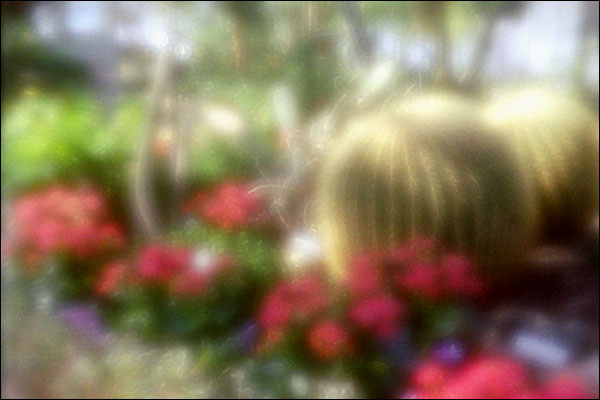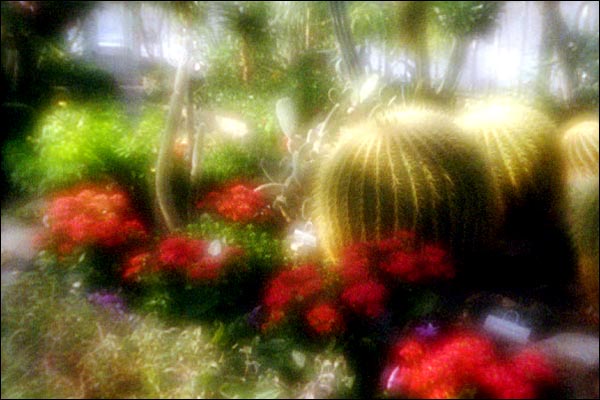Photon & Pinhole Sieve Photography
By Guillermo Peņate Dec/16/2002
Scientists from Universität Kiel and Universität Hamburg in Germany, have developed a novel diffractive optical lens named Photon Sieve, as published in Nature 414, 184-188 (8 November 2001). This Photon Sieve lens was developed for the focusing and imaging of soft-X rays ( www.photonsieve.de ).
A Zone Plate consist of a series of clear and dark concentric rings, these rings have very specific diameters, as calculated by a mathematical formula. The Zone Plate rings edge diffract light, these diffracted light interfere constructively adding up their intensity at the focal point (click here for more about Zone Plates). The newly developed Photon Sieve consist of a large number of appropriately distributed pinholes instead of rings as the diffracting elements. To obtain a distinct first-order focus, the pinholes have to be positioned such that the optical path length from the source via the center of the pinholes to the focal point is an integral number of wavelengths.

If a Zone Plate lens can be used for more mundane purposes as that of making photographic images, I thought that a Photon Sieve could also be used for equal purposes. A Photon Sieve lens is constructed using the same techniques used to make Zone Plates, that is: a drawing on paper of an enlarged and negative version of a Photon Sieve is made, a photographic image of that drawing is taken using high contrast film and then processed in high contrast developer. The resulting Photon Sieve on film has to have the actual size needed/calculated. At the right you can see an image of such Photon Sieve.
A 47mm Photon Sieve lens was made using the above mentioned technique, this lens was then mounted on the body cap of a SLR Nikon Camera. Following, what I believe to be the first Photon Sieve photographic image ever made:


Following the same technique described above, another Photon Sieve -like- lens was manufactured, I call this lens: "Pinhole Sieve" due to the pinhole placed at its center, this pinhole corresponds to the first Zone Plate ring. The Pinhole Sieve also meets the requirement that its pinholes are positioned such that the optical path length from the source via the center of the pinholes to the focal point is an integral number of wavelengths.
A 42 mm Pinhole Sieve was manufactured and also mounted on a 5mm recessed body cap for the same SLR Nikon Camera as above. This Pinhole Sieve was used to make a photographic image of the same scene as the one made with the Photon Sieve, a comparison can be then made of the results obtained with both types of lenses. Following is the image made with this Pinhole Sieve:

To make the comparison of the two images more meaningful, these images have not been subjects of any digital alteration such as sharpening, unsharp mask, added blur, etc. The only digital changes applied to them were an over all brightness and contrast adjustment.
Many thanks to Dr.Lutz Kipp
from the Institute of Experimental and Applied Physics, Kiel University
Germany, who graciously answered questions I had regarding this exciting
new focusing and imaging technique.
For corrections or comments, please contact the author:
Pinholes, Zone Plates, Photon and Pinhole Sieves for SALE!!
Pinhole images:
http://ca.oocities.com/penate@rogers.com/guillermo.html
Zone Plate images:
http://ca.oocities.com/penate@rogers.com/ZP120.html
Zone Plate article:
http://ca.oocities.com/penate@rogers.com/zoneplate.html
Pinhole size and exposure article:
http://ca.oocities.com/penate@rogers.com/pinsize.htm
How to measure Pinholes article:
http://ca.oocities.com/penate@rogers.com/diameter.htm
Photon Sieve article PDF:
http://ca.oocities.com/penate@rogers.com/sieve/photonsieve.pdf
Photon Sieve article HTML:
http://ca.oocities.com/penate@rogers.com/sieve/photonsieve.html
Sieve images compared:
http://ca.oocities.com/penate@rogers.com/sieve/comparison.html